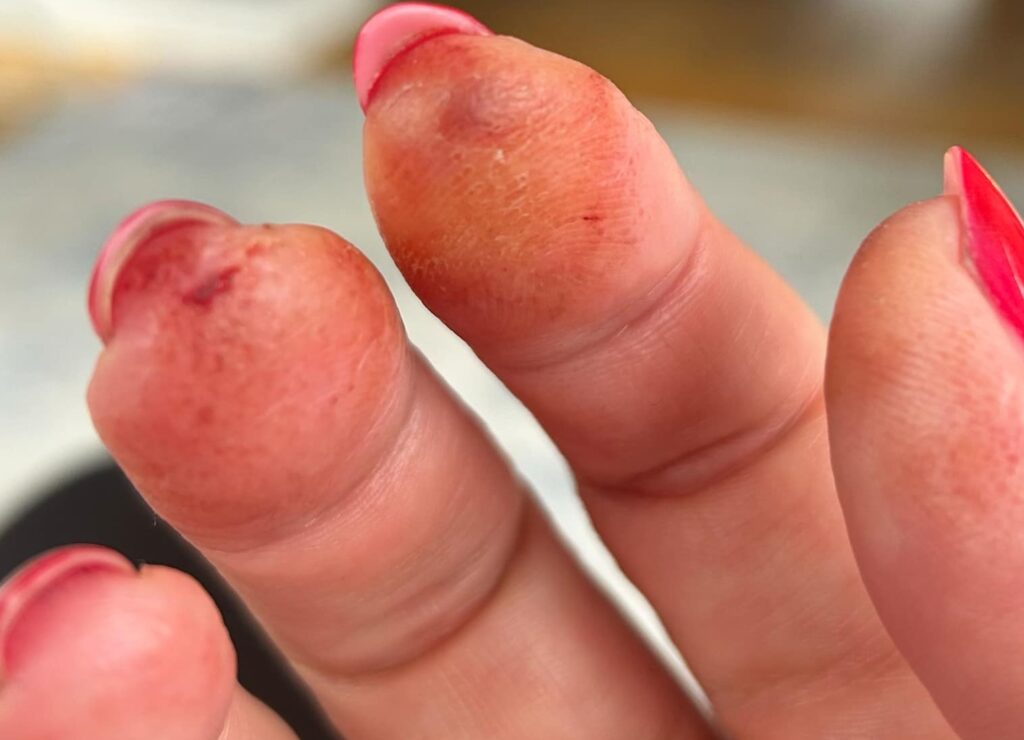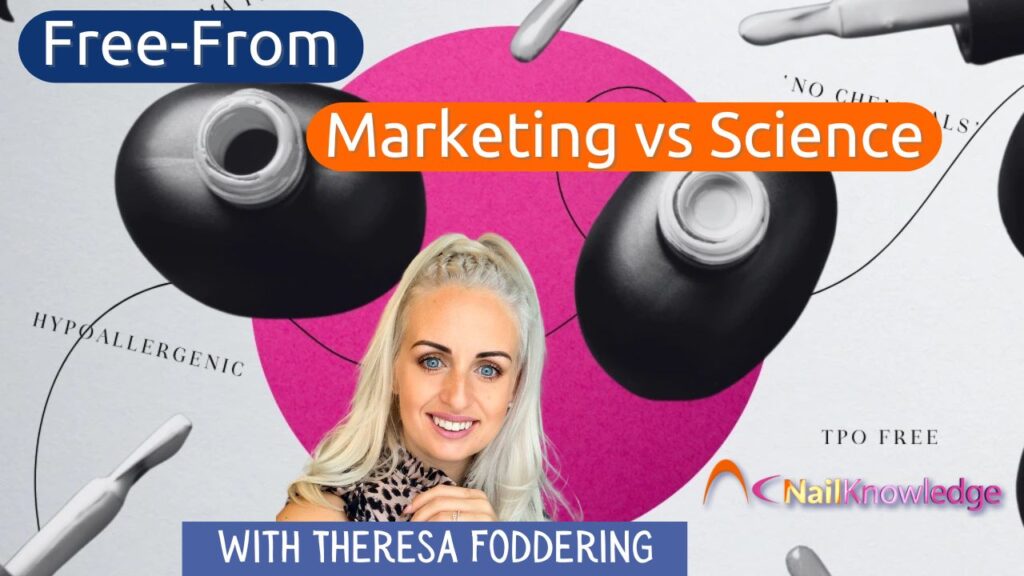Free From Marketing vs. Ciência: Revelando a segurança dos produtos para unhas
As someone deeply embedded in the professional nail and products industry, I’ve seen firsthand how “free-from” claims influence buying decisions, often without a clear understanding of what they actually mean. In this blog, I want to break down the reality of these claims, the science behind allergens, and why critical thinking is beneficial and transparent when evaluating these marketing trends.
Understanding ‘Free-From’ Claims in the Nail Industry
The idea behind “free from” branding is simple: by excluding certain ingredients that have been deemed harmful or allergenic, companies suggest their products are safer or healthier. Common examples include:
- X-Free nail polishes, which claim to exclude formaldehyde, dibutyl phthalate, toluene, and other supposedly harmful chemicals.
- Sem HEMA géis comercializados como uma alternativa mais segura para pessoas propensas a alergias.
- Hipoalergênico produtos
Mas a verdadeira questão é: esses ingredientes já foram uma preocupação real para a maioria dos usuários ou isso é apenas marketing inteligente?
And let’s not overlook the pressure applied in reverse upon companies to join “free from” formulating and marketing claims to ‘give the people what they want’. It’s a double-edged sword and no one seems to be winning.
A ciência dos alérgenos: Tudo é um alérgeno em potencial
One of the biggest misconceptions in “free from” marketing is the assumption that the absence of certain ingredients makes a product safer. The truth is that every substance has the potential to cause an allergic reaction.
Por exemplo:
- Lavender oil – A natural ingredient often used in “natural” beauty, but also a known skin allergen.
- Nozes – Completely natural but can be deadly to those with severe allergies.
- Água – Even water can cause irritant contact dermatitis (ICD) with overexposure.
Yet, we don’t see brands marketing their gels as “free from lavender or nuts,” even though they are just as capable of causing allergic reactions as the ingredients being demonized. This selective marketing plays on fear rather than fact.
Os acrilatos estão em toda parte: Produtos domésticos e exposição diária
Acrylates, particularly those being villainized in nail products, are not unique to the nail industry. Many of these chemicals are found in produtos domésticos e industriais de uso diárioNo entanto, ninguém está se apressando para removê-los desses aplicativos.
Por exemplo:
- Dimetacrilato de etilenoglicol (EGDMA) – Used in plastic bottles for soft drinks, dental materials, printing inks, automobile antifreeze, and engine-cooling liquids.
- Metacrilato de metila (MMA) – Used in medical prosthetics, dental work, and industrial applications, yet banned in liquid monomer form in some countries for nails due to misuse, not because of toxicity when used correctly.
- Metacrilato de hidroxipropila (HPMA) – Found in medical-grade adhesives, contact lenses, and of course, nail coatings.
- Metacrilato de tetrahidrofurfurila (THFMA) – Used in dental materials, artificial nails, and 3D printing, yet has been flagged for its potential allergenic effects.
- Monometacrilato de propilenoglicol (PGMA) – Found in adhesives, cosmetics, and medical devices, but rarely discussed despite being a known allergen.
- Triacrilato de trimetilolpropano (TMPTA) – A multifunctional acrylate monomer used in UV-curable coatings, adhesives, and inks, but like other acrylates, has the potential to cause skin sensitization and allergic reactions in some individuals.
- Metacrilato de benzila – Used in artificial nail products, dental materials, and medical devices. It contributes to the durability of polymer formulations but, like other methacrylates, has the potential to cause allergic reactions in sensitive individuals.
Isso levanta uma questão importante: Se esses produtos químicos são usados com segurança em outros setores sem histeria em massa, por que o setor de unhas é tão reativo a todas as tendências de ingredientes?

Irritantes vs. Alergênicos: Conhecendo a diferença para a segurança dos técnicos de unhas
Outro ponto importante frequentemente ignorado nessas discussões é a diferença entre alergênicos e irritantes. Nem todos os ingredientes que parecem preocupantes são alergênicos; alguns são simplesmente irritantes quando usados de forma inadequada ou em altas concentrações.
Por exemplo:
- Acetato de etila – A common solvent in nail polish and removers, classified as an irritant rather than an allergen.
- Acetona – A well-known, widely used solvent in nail products that can cause skin and respiratory irritation with overexposure but is not classified as an allergen.
- Methacrylic Acid (MAA) – A key organic component used to maximize adhesion between the nail and artificial coating. It is highly reactive and can cause skin and respiratory irritation upon direct exposure. Not considered a strong allergen but certainly a strong irritant.
Então, onde estamos traçando a linha? Estamos escolhendo viver com medo, removendo todo alergênico em potencial, independentemente do contexto? Ou estamos simplesmente esperando que o próximo pânico de ingredientes seja imposto a nós?
A controvérsia sobre o HEMA: Troca de ingredientes ou progresso real?
One of the biggest ingredient shifts we’ve seen in recent years is the demonization of HEMA (Hydroxyethyl Methacrylate). Initially flagged due to allergic reactions in some users, the backlash against HEMA led to the rise of HEMA-free alternatives using IBOA (Isobornyl Acrylate) and HPMA (Hydroxypropyl Methacrylate). But now, we’re seeing the same cycle—concerns beginning to emerge over these replacement ingredients….
Isso levanta um ponto crítico: Será que estamos realmente tornando os produtos mais seguros ou apenas jogando um jogo interminável de troca de ingredientes?
The truth is any acrylate or methacrylate-based system carries a potential risk of allergy. The real solution isn’t just removing ingredients but focusing on proper education, safe application, and correct handling.
I have worked with, handled, and discussed formulations for over 20 years—before the panic, before the quick-fix courses, and before the constant, in-your-face marketing. I’m all for growth, knowledge, and awareness, but I often question: how did we get here? And will we ever find a way out?
Pensamento crítico: O que são produtos para unhas? Realmente Livre de?
Whenever I’m asked, “What’s the best free-from brand?” minha resposta é: “I can tell you what it’s NOT free from.”
I then list random natural allergens—lavender, pollen, nuts—to drive home the point that free from does not mean safer. More often than not, this sparks a “lightbulb moment,” where professionals realize how flawed this approach is.
The only time I’ve ever received pushback was from someone affiliated with a brand that heavily markets itself as 10-free. They argued that I couldn’t dismiss something I didn’t understand. I clarified that I don’t misunderstand—I simply refuse to support misleading marketing designed to manipulate professionals and consumers for profit. Seguiu-se o silêncio.
A conversa real: Uso e aplicação seguros de produtos para unhas
Em vez de se fixar em what’s NOT in our productsPrecisamos mudar a conversa para como usá-los de forma segura e eficaz. Isso significa que:
- Ventilação e extração adequadas em salões de beleza.
- Uso de luvas.
- Manter os espaços de trabalho, equipamentos e frascos de produtos limpos e livres de resíduos.
- Aplicação correta para minimizar o contato com a pele.
- Educar profissionais (e clientes) sobre preocupações reais de segurança em vez de marketing baseado em medo.
O objetivo deve ser sempre science-backed education, not chasing the next “bad” ingredient.
Referências
- DermNet NZ (n.d.) Alergia ao acrilato. Disponível em: https://dermnetnz.org/topics/allergy-to-acrylate (Acesso em: 03/04/25).
- Steunebrink, I.M., de Groot, A. e Rustemeyer, T. (2024) ‘Contact allergy to acrylate-containing nail cosmetics: A retrospective 8-year study’, Dermatite de contato, 90(3), pp. 262–265. Available at: https://pubmed.ncbi.nlm.nih.gov/38093676/ (Acesso em: 03/03/25)
- Biblioteca Nacional de Medicina (n.d.) Tetrahydrofurfuryl Methacrylate – GHS Classification. Disponível em: https://pubchem.ncbi.nlm.nih.gov/compound/Tetrahydrofurfuryl-Methacrylate#section=GHS-Classification (Acesso em: 03/04/25).
- Associação Britânica de Dermatologistas (2018) Dermatologistas alertam sobre epidemia de alergia a unhas artificiais no Reino Unido. Disponível em: https://www.bad.org.uk/dermatologists-issue-warning-about-uk-artificial-nail-allergy-epidemic/ (Acesso em: 28/02/25).
- DermNet NZ (n.d.) Alergia de contato ao propilenoglicol. Disponível em: https://dermnetnz.org/topics/contact-allergy-to-propylene-glycol (Acesso em: 28/02/25).
- Wen, L., Zhang, X., Wang, M., Wang, W., Gao, Y. e Zhang, J. (2017) ‘Effect of propylene glycol monomethacrylate on allergic reactions in humans: A systematic review’, Journal of Allergy and Clinical Immunology (Jornal de Alergia e Imunologia Clínica), 140(2), pp. 500–507. Available at: https://pubmed.ncbi.nlm.nih.gov/28656588/ (Acesso em: 03/07/25)
- Departamento de Saúde de Nova Jersey (n.d.) Ficha informativa sobre substâncias perigosas do Right to Know: Acetona. Disponível em: https://nj.gov/health/eoh/rtkweb/documents/fs/0841.pdf (Acesso em: 05/03/25).
- Liu, X. et al. (2023) ‘Occupational exposure to acrylates and associated health risks’, Perspectivas de saúde ambiental. Disponível em: https://pmc.ncbi.nlm.nih.gov/articles/PMC9823182/ (Acesso em: 05/03/25).
- Governo do Reino Unido (2022) Acetona: Informações gerais. Disponível em: https://www.gov.uk/government/publications/acetone-properties-and-incident-management/acetone-general-information (Acesso em: 02/04/25).
- Fowler, J. F. Jr. (2006) ‘Acrylate allergy in nail cosmetics’, Dermatite, 17(2), pp. 57-60. Disponível em: https://pubmed.ncbi.nlm.nih.gov/16596768/ (Acesso em: 28/02/25).
- Departamento de Controle de Substâncias Tóxicas (2024) Methyl Methacrylate in Nail Products. Available at: https://dtsc.ca.gov/wp-content/uploads/sites/31/2024/10/Profile_Methyl-Methacrylate-in-Nail-Products_FINAL.pdf (Acesso em: 05/03/25).
- Biblioteca Nacional de Medicina (2021) Alergia ao acrilato e exposição ocupacional. Disponível em: https://pmc.ncbi.nlm.nih.gov/articles/PMC8501444/ (Acesso em: 03/09/25).
- Agência Europeia de Produtos Químicos (n.d.) Benzyl Methacrylate – Substance Information. Disponível em: https://echa.europa.eu/substance-information/-/substanceinfo/100.017.887#:~:text=Warning!,and%20may%20cause%20respiratory%20irritation.&text=This%20substance%20is%20registered%20under,industrial%20sites%20and%20in%20manufacturing (Acesso em: 03/09/25).


